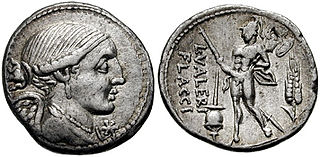Branches and cognomina
The family-names of the Licinii are Calvus (with the agnomina Esquilinus and Stolo), Crassus (with the agnomen Dives), Geta, Lucullus, Macer, Murena, Nerva, Sacerdos, and Varus. The other cognomina of the gens are personal surnames, rather than family-names; these include Archias, Caecina, Damasippus, Imbrex, Lartius, Lenticula, Nepos, Proculus, Regulus, Rufinus, Squillus, and Tegula. The only cognomina which occur on coins are Crassus, Macer, Murena, Nerva, and Stolo. A few Licinii are known without a surname; most of these in later times were freedmen. [3]
The surname Calvus was originally given to a person who was bald, [7] and it was the cognomen of the earliest family of the Licinii to distinguish itself under the Republic. The first of this family bore the agnomen Esquilinus, probably because he lived on the Esquiline Hill. [8] Stolo, a surname given to the most famous of the family, may be derived from the stola, a long outer garment or cloak, or might also refer to a branch, or sucker. [9] [10] Although the family of the Licinii Calvi afterward vanished into obscurity, the surname Calvus was later borne by the celebrated orator and poet Gaius Licinius Macer, who lived in the first century BC. His cognomen Macer, designated someone who was lean. [7] [11] [12]
Another family of the Licinii bore the cognomen Varus, which means "crooked, bent," or "knock-kneed." [4] The Licinii Vari were already distinguished, when their surname was replaced by that of Crassus. This was a common surname, which could mean "dull, thick," or "solid," and may have been adopted because of the contrast between this meaning and that of Varus. [7] [12]
The surname Dives, meaning "rich" or "wealthy," was borne by some of the Licinii Crassi. [13] It was most famous as the surname of Marcus Licinius Crassus, the triumvir, and has been ascribed to his father and brothers, but it is not altogether certain whether it originated with his father, or with the triumvir, in which case it was retroactively applied to the previous generation. [14] [15] [16]
Lucullus, the cognomen of a branch of the Licinii, which first occurs in history towards the end of the Second Punic War, is probably derived from lucus, a grove, or perhaps a diminutive of the praenomen Lucius . The surname does not appear on any coins of the gens. [17] [18]
A family of the Licinii bore the surname Murena (sometimes, but erroneously, written Muraena), referring to the sea-fish known as the murry or lamprey, a prized delicacy since ancient times. This family came from the city of Lanuvium, to the southeast of Rome, and was said to have acquired its name because one of its members had a great liking for lampreys, and built tanks for them. The same surname occurring in other families might be said to be derived from the type of shellfish known as murex , from which a valuable dye was extracted. [17] [19] [20] [21] [22]
Of the other surnames of the Licinii might be mentioned Nerva, the surname of a family of the Licinii that flourished from the time of the Second Punic War until the early Empire, derived from nervus, "sinewy"; [7] Geta, perhaps the name of a Thracian people, to whom one of the Licinii might have been compared; [23] and Sacerdos, a priest, one of a number of cognomina derived from occupations. [24] [25]

![Denarius minted in 47-46 BC at Utica. The reverse alludes to the propraetorian imperium of P. Crassus Junianus (P CRASSVS IV[N]). Pompeians Scipio Crassus Junianus.jpg](http://upload.wikimedia.org/wikipedia/commons/thumb/b/b1/Pompeians_Scipio_Crassus_Junianus.jpg/220px-Pompeians_Scipio_Crassus_Junianus.jpg)





